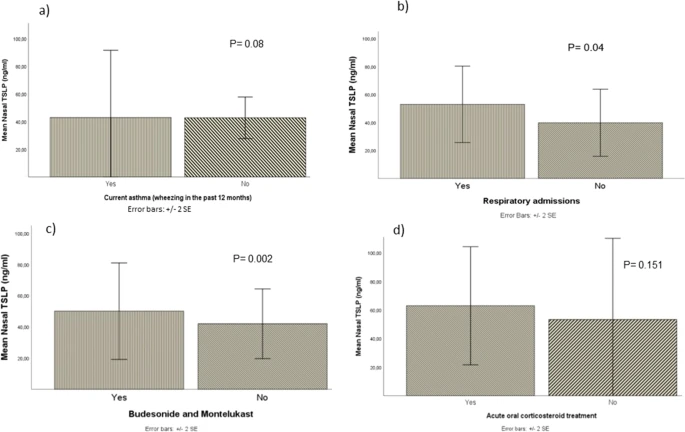Research – Open Access
Maria Luz Garcia-Garcia, Beatriz Sastre, Maria Arroyas, Maite Beato, Patricia Alonso, José Manuel Rodrigo-Muñoz, Victoria Del Pozo, Inmaculada Casas & Cristina Calvo
Respiratory Research volume 24, Article number: 26 (2023)
Abstract
Background
Severe bronchiolitis is often associated with subsequent respiratory morbidity, mainly recurrent wheezing and asthma. However, the underlying immune mechanisms remain unclear. The main goal of this study was to investigate the association of nasal detection of periostin and thymic stromal lymphopoietin (TSLP) during severe bronchiolitis with the development of asthma at 4 years of age.
Methods
Observational, longitudinal, post-bronchiolitis, hospital-based, follow-up study. Children hospitalized for bronchiolitis between October/2013 and July/2017, currently aged 4 years, included in a previous study to investigate the nasal airway secretion of TSLP and periostin during bronchiolitis, were included. Parents were contacted by telephone, and were invited to a clinical interview based on a structured questionnaire to obtain information on the respiratory evolution. The ISAAC questionnaire for asthma symptoms for 6–7-year-old children, was also employed.
Results
A total of 248 children were included (median age 4.4 years). The mean age at admission for bronchiolitis was 3.1 (IQR: 1.5–6.5) months. Overall, 21% had ever been diagnosed with asthma and 37% had wheezed in the last 12 months. Measurable nasal TSLP was detected at admission in 27(11%) cases and periostin in 157(63%). The detection of nasal TSLP was associated with the subsequent prescription of maintenance asthma treatment (p = 0.04), montelukast (p = 0.01), and the combination montelukast/inhaled glucocorticosteroids (p = 0.03). Admissions for asthma tended to be more frequent in children with TSLP detection (p = 0.07). In the multivariate analysis, adjusting for potential confounders, the detection of TSLP remained independently associated with chronic asthma treatment prescription (aOR:2.724; CI 1.051–7.063, p:0.04) and with current asthma (aOR:3.41; CI 1.20–9.66, p:0.02).

Nasal detection of periostin was associated with lower frequency of ever use of short-acting beta2-agonists (SABA) (p = 0.04), lower prevalence of current asthma (p = 0.02), less prescription of maintenance asthma treatment in the past 12 months (p = 0.02, respectively). In the multivariate analysis, periostin was associated with lower risk of asthma at 4 years, independently of the atopic status (aOR:0.511 CI 95% 0.284–0.918, p:0.025).
Conclusions
Our results show a positive correlation between nasal TSLP detection in severe bronchiolitis and the presence of current asthma, prescription of asthma maintenance treatment and respiratory admissions up to the age of 4 years. By contrast, we found a protective association between nasal periostin detection and current asthma at 4 years, ever diagnosis of asthma, maintenance asthma treatment prescription, and respiratory admissions.
